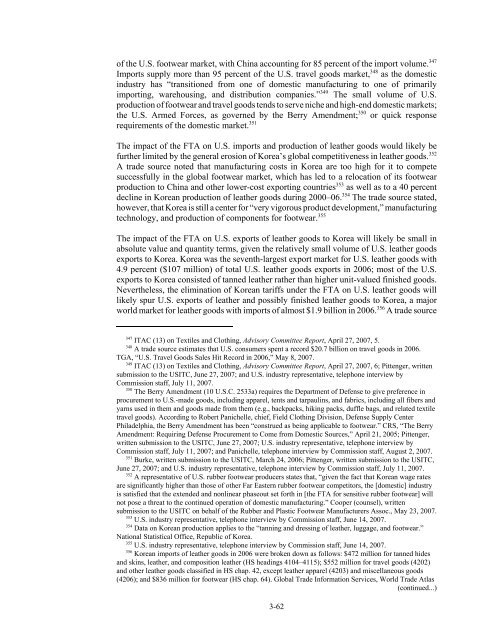U.S.-Korea Free Trade Agreement: Potential Economy-wide ... - USITC
U.S.-Korea Free Trade Agreement: Potential Economy-wide ... - USITC
U.S.-Korea Free Trade Agreement: Potential Economy-wide ... - USITC
You also want an ePaper? Increase the reach of your titles
YUMPU automatically turns print PDFs into web optimized ePapers that Google loves.
of the U.S. footwear market, with China accounting for 85 percent of the import volume. 347<br />
Imports supply more than 95 percent of the U.S. travel goods market, 348 as the domestic<br />
industry has “transitioned from one of domestic manufacturing to one of primarily<br />
importing, warehousing, and distribution companies.” 349 The small volume of U.S.<br />
production of footwear and travel goods tends to serve niche and high-end domestic markets;<br />
the U.S. Armed Forces, as governed by the Berry Amendment; 350 or quick response<br />
requirements of the domestic market. 351<br />
The impact of the FTA on U.S. imports and production of leather goods would likely be<br />
further limited by the general erosion of <strong>Korea</strong>’s global competitiveness in leather goods. 352<br />
A trade source noted that manufacturing costs in <strong>Korea</strong> are too high for it to compete<br />
successfully in the global footwear market, which has led to a relocation of its footwear<br />
production to China and other lower-cost exporting countries 353 as well as to a 40 percent<br />
decline in <strong>Korea</strong>n production of leather goods during 2000–06. 354 The trade source stated,<br />
however, that <strong>Korea</strong> is still a center for “very vigorous product development,” manufacturing<br />
technology, and production of components for footwear. 355<br />
The impact of the FTA on U.S. exports of leather goods to <strong>Korea</strong> will likely be small in<br />
absolute value and quantity terms, given the relatively small volume of U.S. leather goods<br />
exports to <strong>Korea</strong>. <strong>Korea</strong> was the seventh-largest export market for U.S. leather goods with<br />
4.9 percent ($107 million) of total U.S. leather goods exports in 2006; most of the U.S.<br />
exports to <strong>Korea</strong> consisted of tanned leather rather than higher unit-valued finished goods.<br />
Nevertheless, the elimination of <strong>Korea</strong>n tariffs under the FTA on U.S. leather goods will<br />
likely spur U.S. exports of leather and possibly finished leather goods to <strong>Korea</strong>, a major<br />
world market for leather goods with imports of almost $1.9 billion in 2006. 356 A trade source<br />
347 ITAC (13) on Textiles and Clothing, Advisory Committee Report, April 27, 2007, 5.<br />
348 A trade source estimates that U.S. consumers spent a record $20.7 billion on travel goods in 2006.<br />
TGA, “U.S. Travel Goods Sales Hit Record in 2006,” May 8, 2007.<br />
349 ITAC (13) on Textiles and Clothing, Advisory Committee Report, April 27, 2007, 6; Pittenger, written<br />
submission to the <strong>USITC</strong>, June 27, 2007; and U.S. industry representative, telephone interview by<br />
Commission staff, July 11, 2007.<br />
350 The Berry Amendment (10 U.S.C. 2533a) requires the Department of Defense to give preference in<br />
procurement to U.S.-made goods, including apparel, tents and tarpaulins, and fabrics, including all fibers and<br />
yarns used in them and goods made from them (e.g., backpacks, hiking packs, duffle bags, and related textile<br />
travel goods). According to Robert Panichelle, chief, Field Clothing Division, Defense Supply Center<br />
Philadelphia, the Berry Amendment has been “construed as being applicable to footwear.” CRS, “The Berry<br />
Amendment: Requiring Defense Procurement to Come from Domestic Sources,” April 21, 2005; Pittenger,<br />
written submission to the <strong>USITC</strong>, June 27, 2007; U.S. industry representative, telephone interview by<br />
Commission staff, July 11, 2007; and Panichelle, telephone interview by Commission staff, August 2, 2007.<br />
351 Burke, written submission to the <strong>USITC</strong>, March 24, 2006; Pittenger, written submission to the <strong>USITC</strong>,<br />
June 27, 2007; and U.S. industry representative, telephone interview by Commission staff, July 11, 2007.<br />
352 A representative of U.S. rubber footwear producers states that, “given the fact that <strong>Korea</strong>n wage rates<br />
are significantly higher than those of other Far Eastern rubber footwear competitors, the [domestic] industry<br />
is satisfied that the extended and nonlinear phaseout set forth in [the FTA for sensitive rubber footwear] will<br />
not pose a threat to the continued operation of domestic manufacturing.” Cooper (counsel), written<br />
submission to the <strong>USITC</strong> on behalf of the Rubber and Plastic Footwear Manufacturers Assoc., May 23, 2007.<br />
353 U.S. industry representative, telephone interview by Commission staff, June 14, 2007.<br />
354 Data on <strong>Korea</strong>n production applies to the “tanning and dressing of leather, luggage, and footwear.”<br />
National Statistical Office, Republic of <strong>Korea</strong>.<br />
355 U.S. industry representative, telephone interview by Commission staff, June 14, 2007.<br />
356 <strong>Korea</strong>n imports of leather goods in 2006 were broken down as follows: $472 million for tanned hides<br />
and skins, leather, and composition leather (HS headings 4104–4115); $552 million for travel goods (4202)<br />
and other leather goods classified in HS chap. 42, except leather apparel (4203) and miscellaneous goods<br />
(4206); and $836 million for footwear (HS chap. 64). Global <strong>Trade</strong> Information Services, World <strong>Trade</strong> Atlas<br />
(continued...)<br />
3-62

















